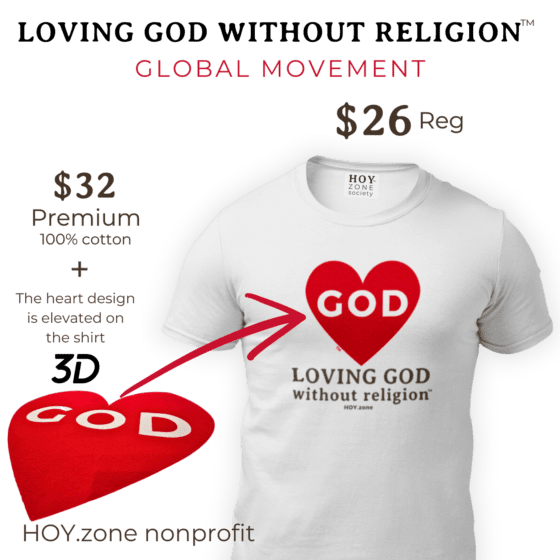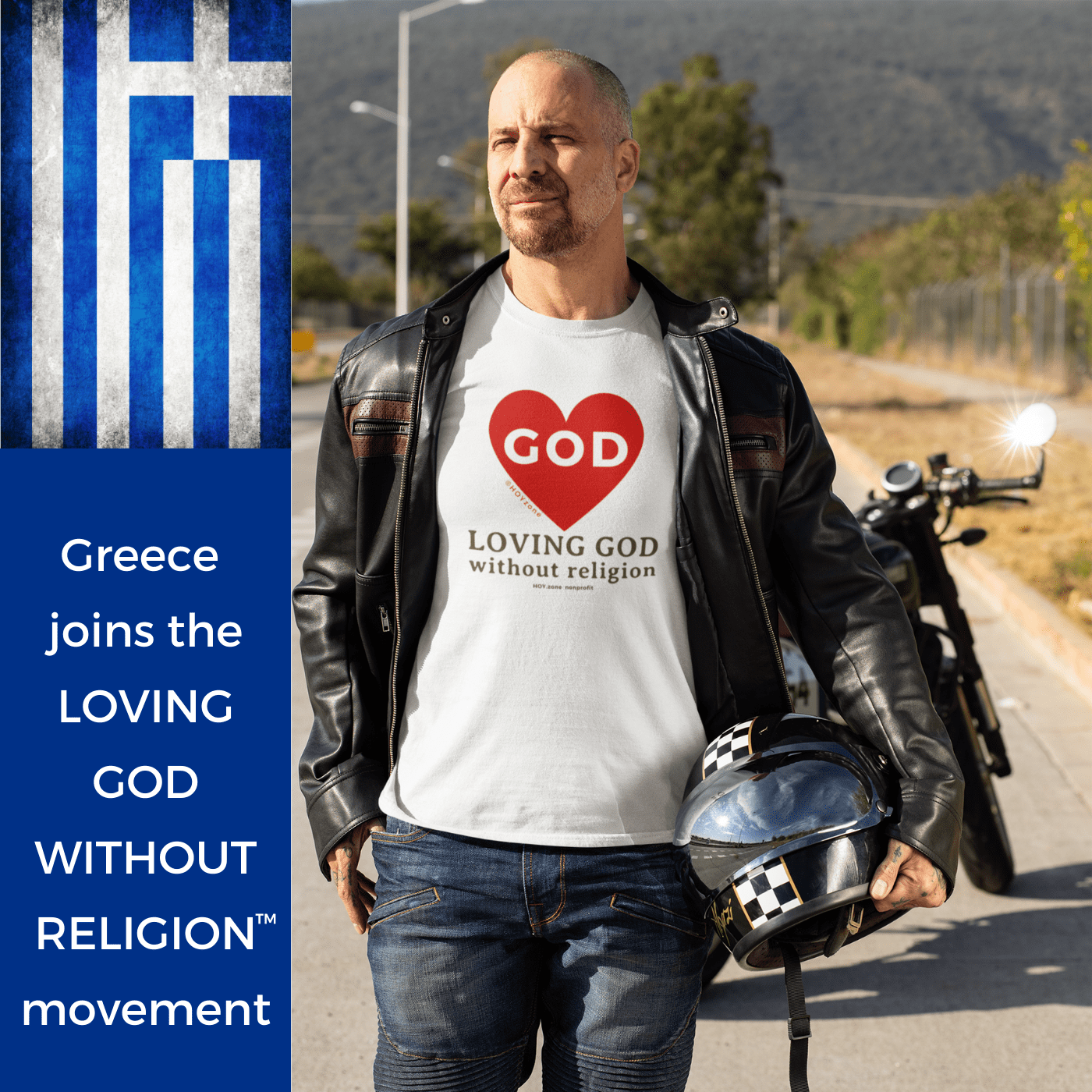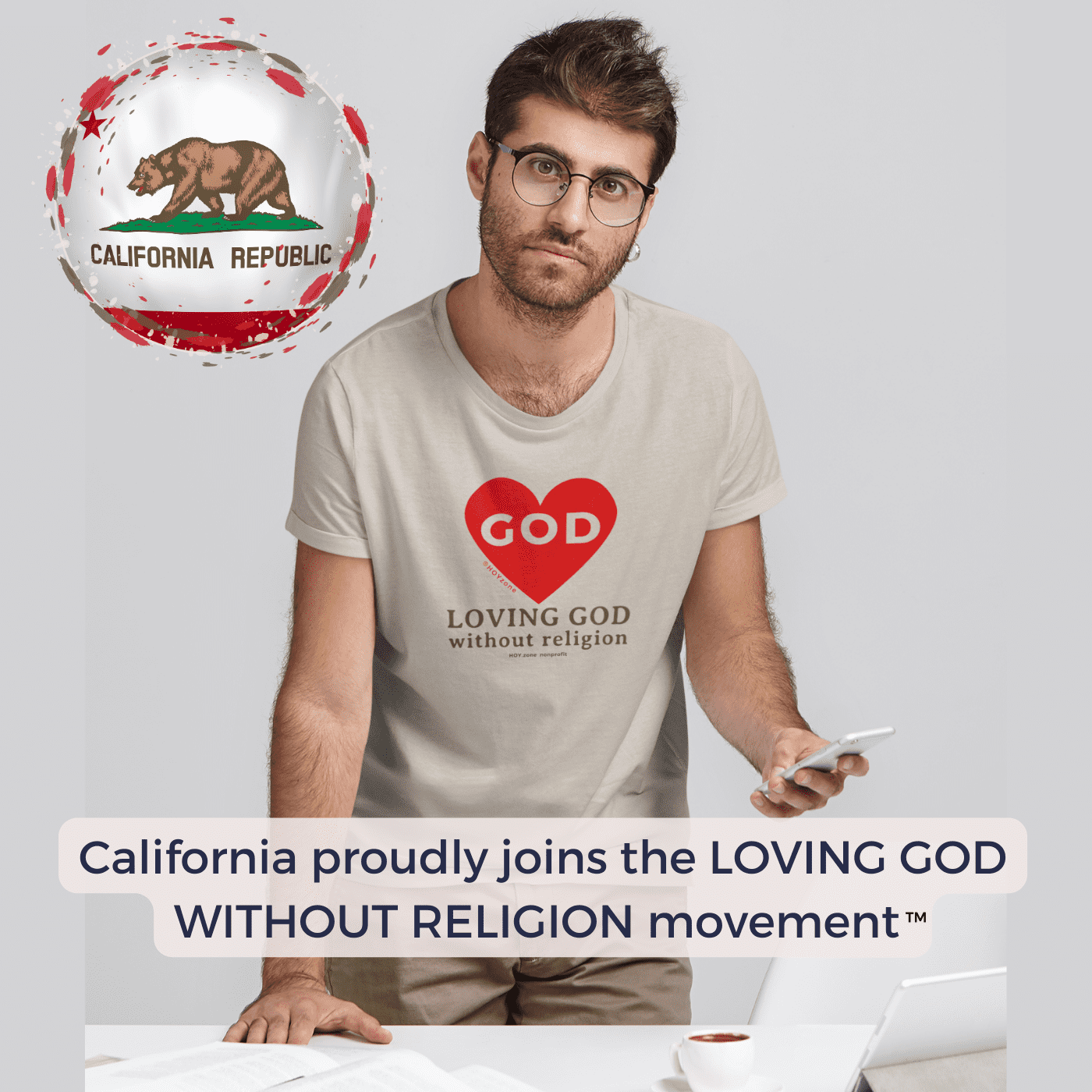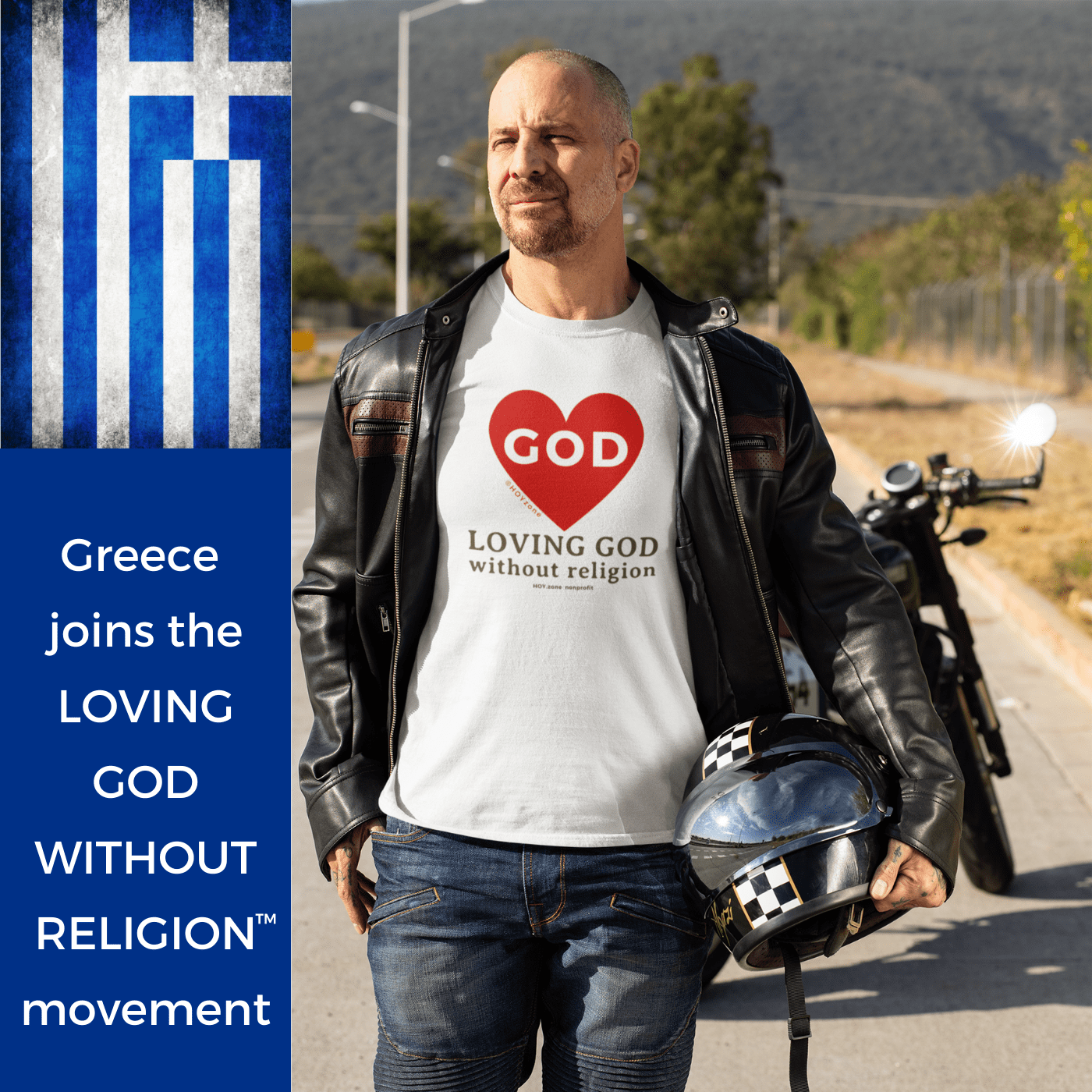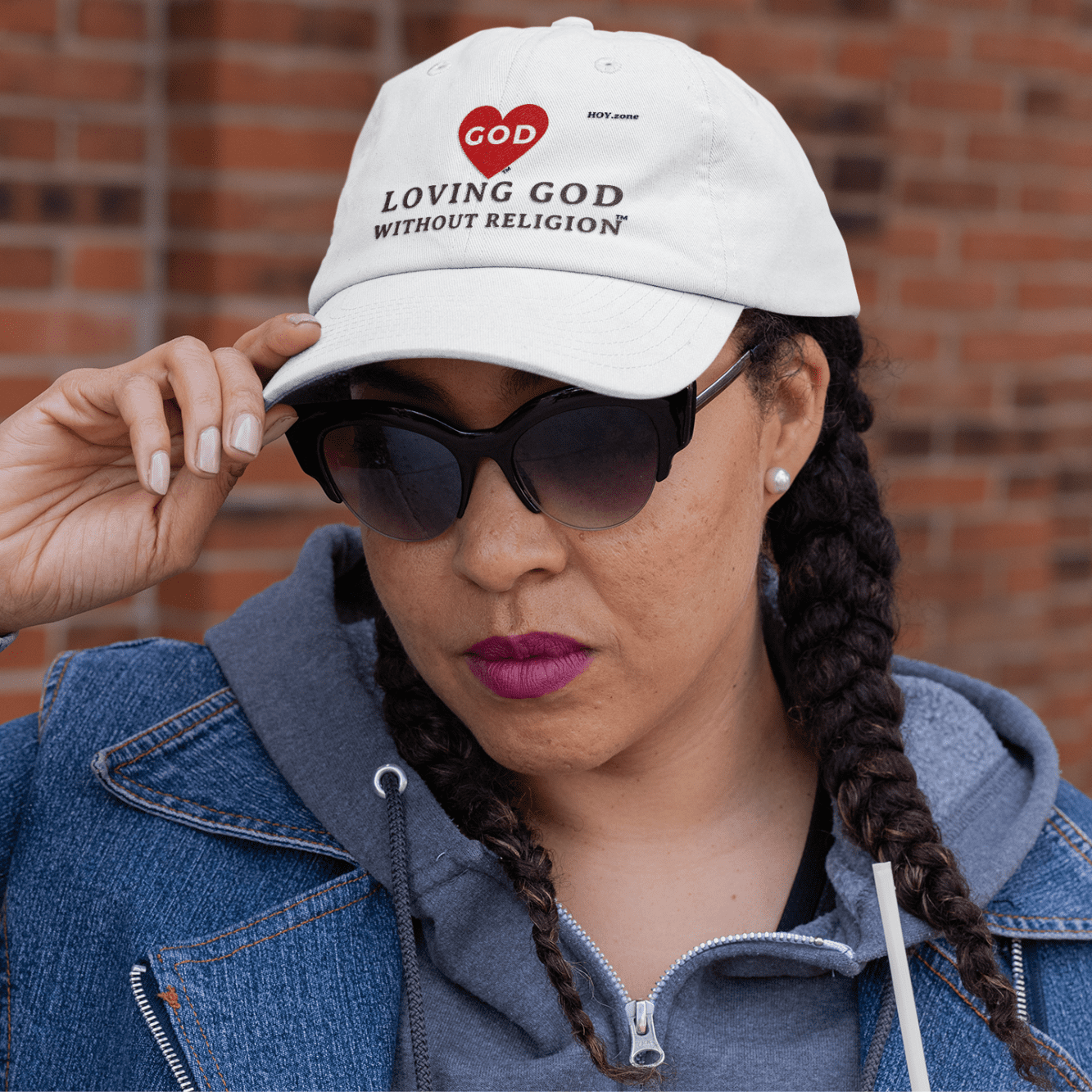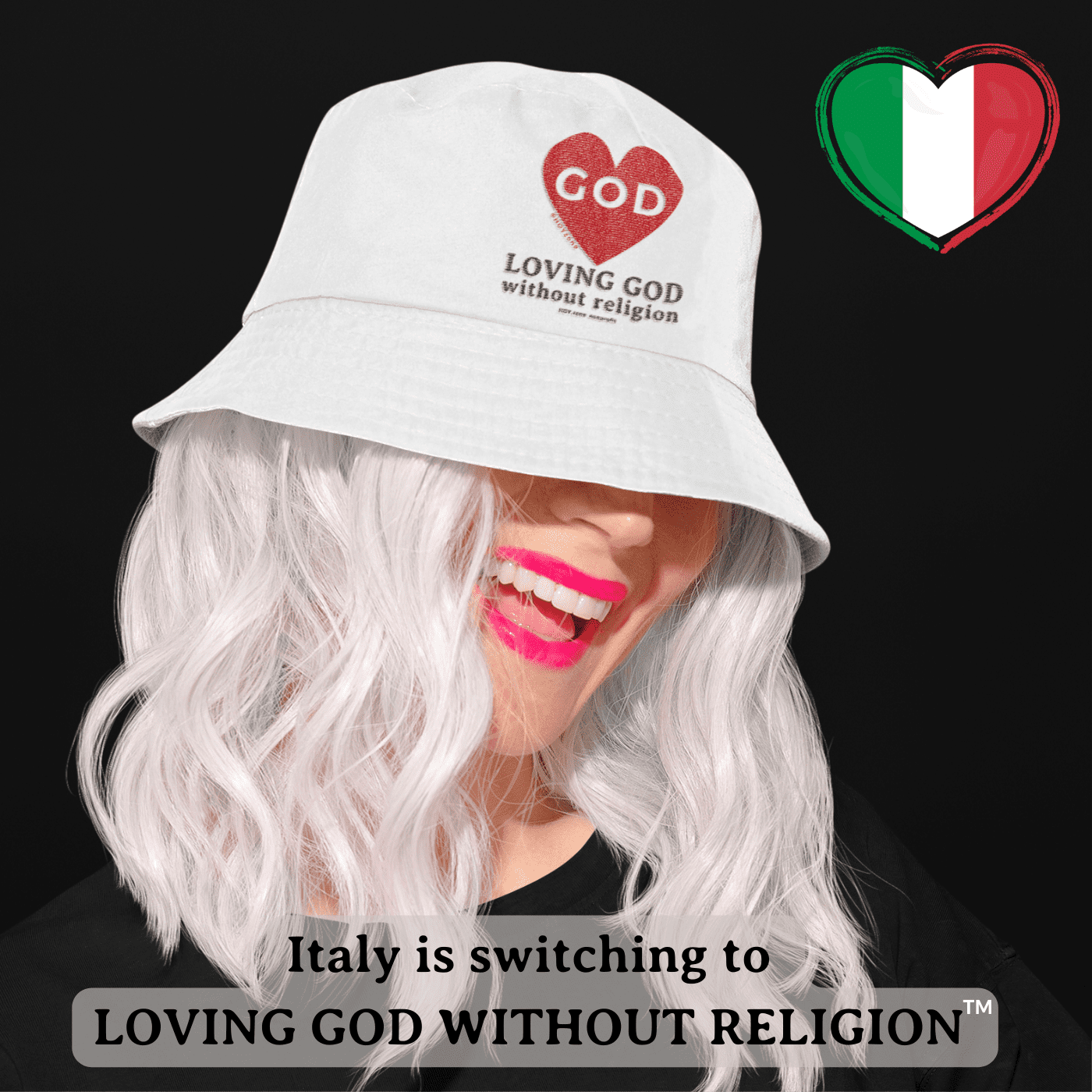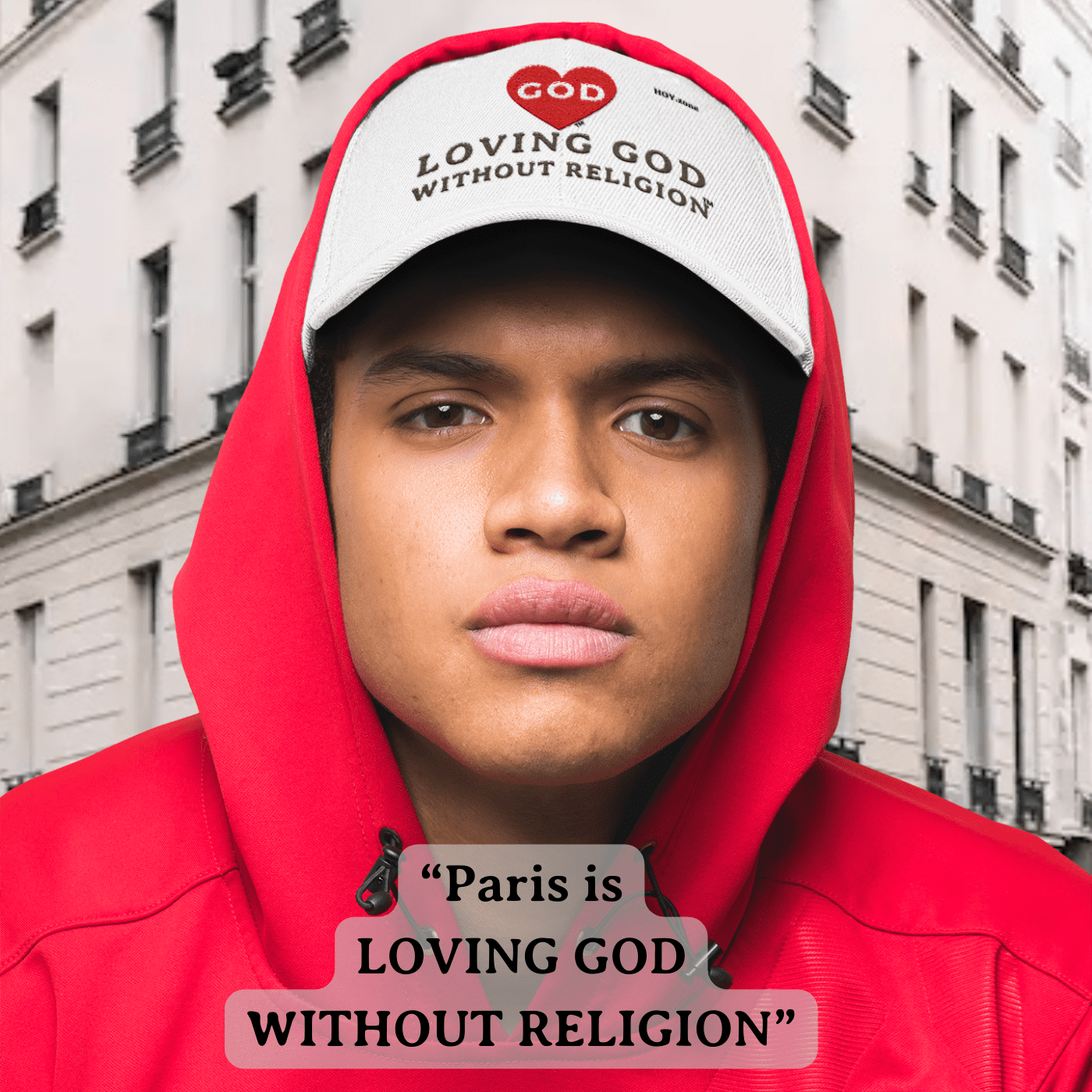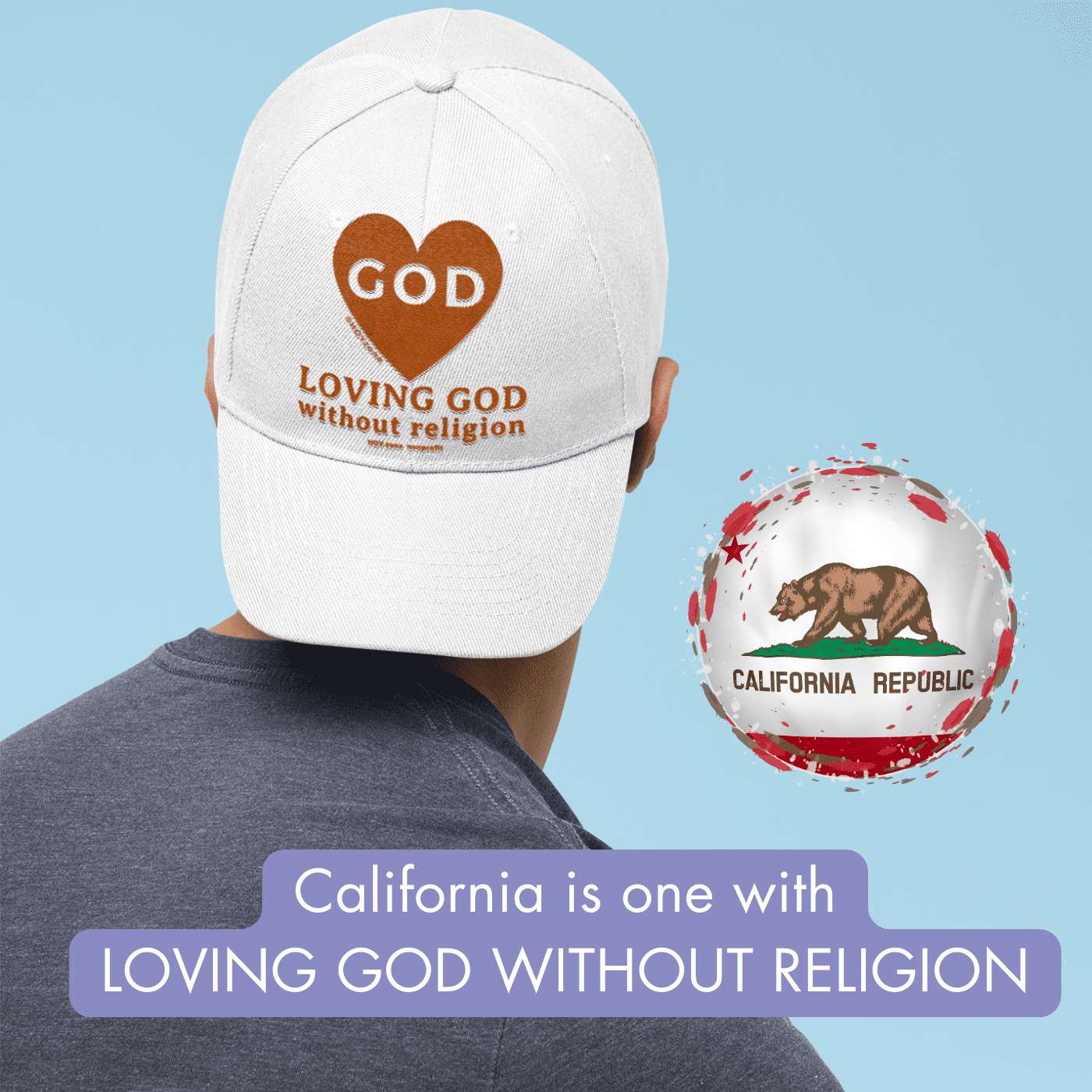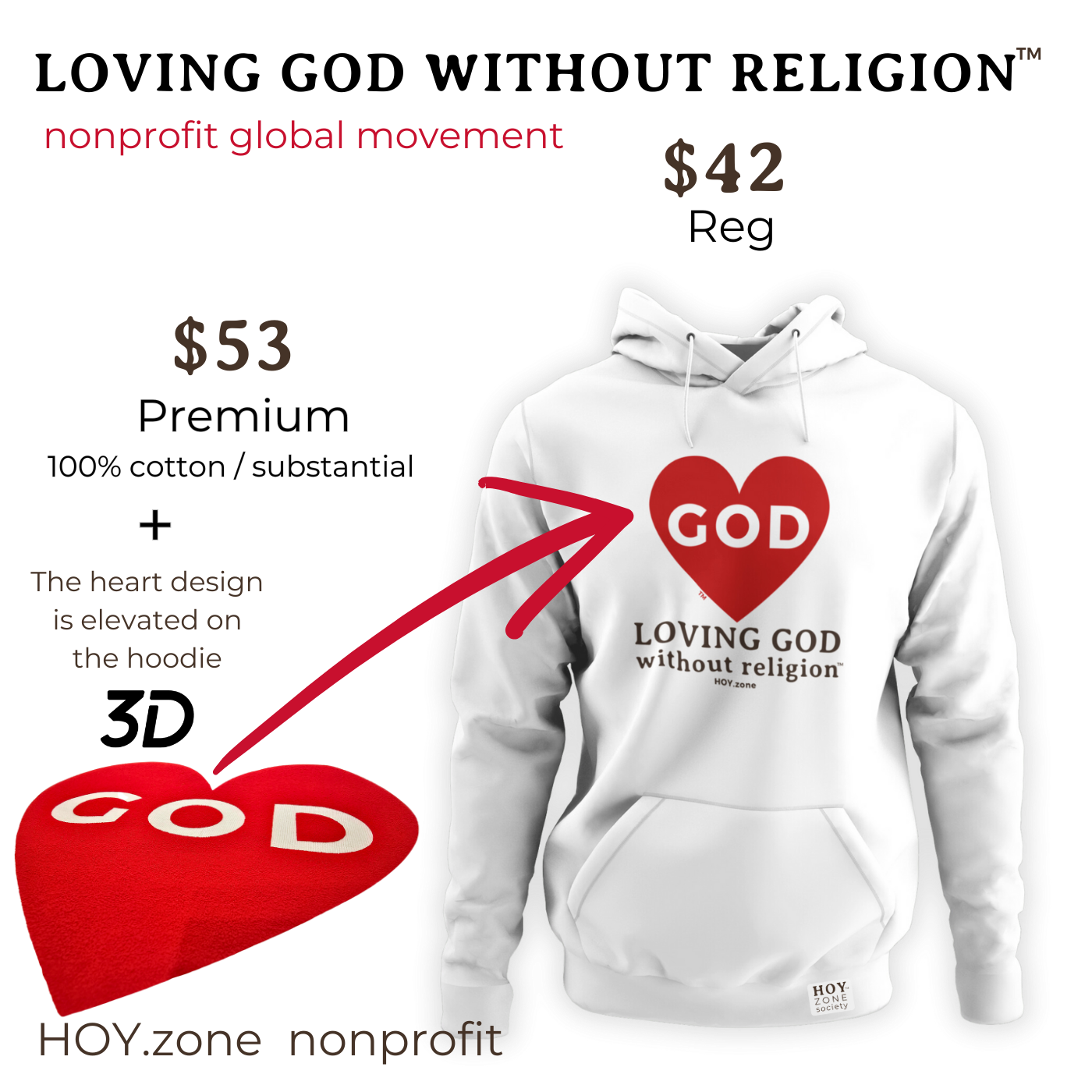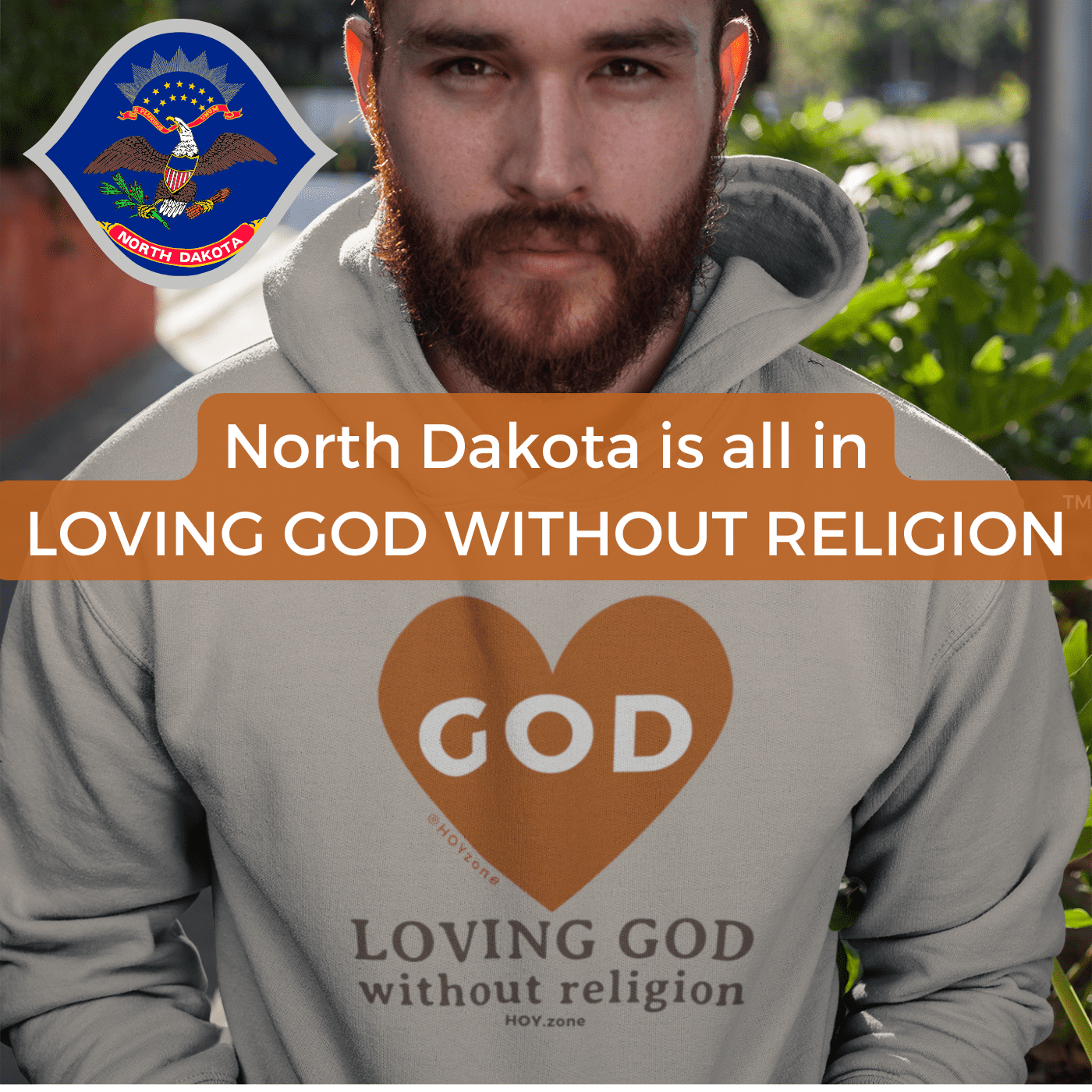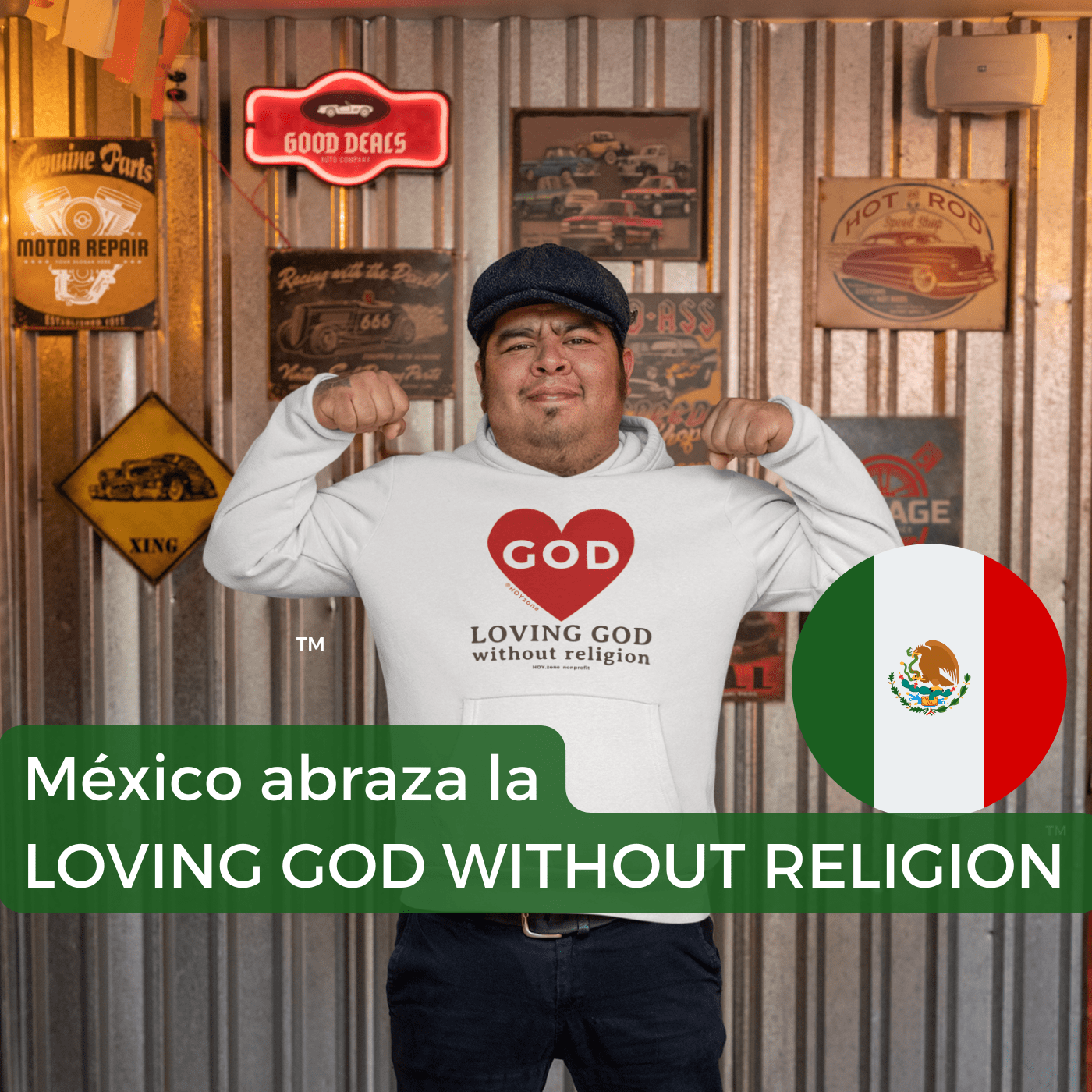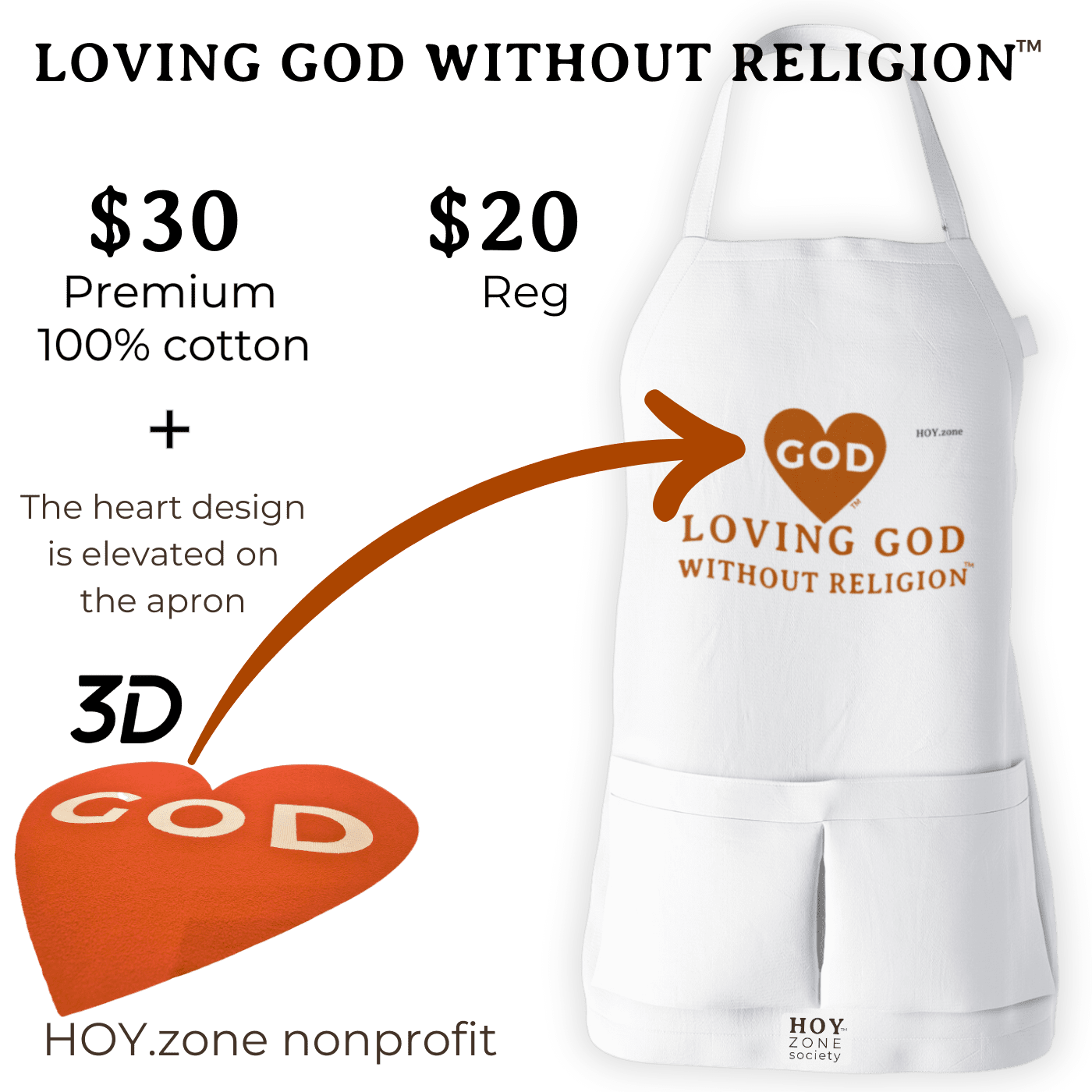LOVING GOD WITHOUT RELIGION
Global nonprofit fashion initiative advocating love for God, rooted in the original Bible, not fear-based religion.
closer2GOD nonprofit global ashion initiative rooted in the original Bible free of religious scare.
Our mission at LOVING GOD WITHOUT RELIGION is to guide individuals on a genuine spiritual journey towards a purposeful life, anchored solely in the immutable wisdom of the Original Bible. We reject the distortions found in human-translated versions and religious doctrines, advocating instead for an authentic relationship with God, untainted by human interpretation or manipulation. Through education, community engagement, and the dissemination of research findings by the Original Bible Foundation, we empower individuals to align their morals and conscience directly with God’s eternal word. This direct connection fosters inner freedom, nurtures self-esteem, and brings people authentically closer to God.
closer2GOD nonprofit global fashion initiative rooted in the original Bible free of religious scare.
❤️ GOD WEAR FAQ
All the human-translated “Bibles” originated from the only one original Bible, which is the WORD OF GOD: one string of 1,197,000 Hebrew letters that is coded with GOD’s messaging to humanity but is not convenient to read. The original Bible was created by adding spaces to divide it into 305,490 words, 23,206 verses, 929 chapters, and 39 books. Source: code2GOD.org
You possess a Biblical name inscribed in the sacred letters of the original Bible. God has assigned a unique numerical code, ranging from 1 to 400, to each of the 22 holy letters in the Biblical language.

Elizabeth originated from the original Bible name Elisheva אלישבע with code2GOD of 413. Elisheva means “Devoted to God; Pledged to God” and was the wife of Aaron Exodus 6:23
James originated from the original Bible Genesis 25:19 name יעקב Yaakov (Jacob) to Greek Iakobos, then to Latin Iacobus, then French Jacques, and finally to the English name James. יעקב code2GOD is 182.
Last names have less original Bible origination.
God encoded each of the 22 Biblical letters with a unique number from 1 to 400. Each full name, therefore, carries a meaningful code directing to one original Bible verse out of 23,206. This verse can represent who you are or/and your life path.
Example: God changes Sarai’s שרי name to Sarah שרה, so she would be able to get pregnant, and so she did. The name and its code impact destiny.
Example: the name Jacob יעקב, meaning “supplanter” or “heel-grabber,” was transformed by God into Israel ישראל (code2GOD 541), meaning “one who strives with God.” This change occurred after Jacob wrestled with an angel and displayed his determination and resilience. The new name represented Jacob’s transformation, signifying his spiritual journey and his new identity as the father of the twelve tribes of Israel. These examples illustrate how the power within the biblical name codes reflects divine intervention, personal growth, and the fulfillment of God’s purpose.
Your purchase serves as a donation with multiple meaningful impacts:
Terminally Ill Cancer Patients: A portion of your purchase goes toward supporting terminally ill cancer patients and their families. These individuals receive comfort and spiritual guidance through the Biblical code related to “after death,” providing solace during challenging times.
Original Bible Foundation: Your contribution aids in the continuation of vital research on the original Bible code. This research is dedicated to enhancing our understanding of the true God, furthering spiritual knowledge, and promoting a deeper connection with the divine.
Holy Land Ministry: Additionally, your purchase supports the Holy Land Ministry, which plays a crucial role in spreading spiritual insights and fostering a closer connection to God.
By making a purchase, you are making a positive impact on these important causes while, also benefiting from your personalized HOYzone wear.
Jesus, who has a direct connection to God, would appreciate the focus of HOYzone which relies solely on the original Bible and utilizing code2GOD to understand and connect with God. Jesus trusted in God but opposed religious manipulation.
To draw closer to God, HOYzone emphasizes the significance of relying on the original Bible, which was divinely created and coded. Human translations may contain flaws and lack the true essence. For example, the King James Version (KJV) introduced the term “unicorns” instead of accurately translating the animal as “oryx” in the original Bible. Similarly, the use of “heavens” in KJV, instead of “skies,” inaccurately portrays the earth as “hell.”
Many religions manipulate the original Bible to suit their own narratives, akin to marketing tactics employed by brand names. HOYzone respects religions that present the source without manipulation or fear-based strategies.
Deep reverence is held for Jesus, Moses, and all messengers and representatives of God.
Your purchase from HOY zone (EIN 93-1872841 501(c)3 public charity), qualifies as a donation, and you can claim a donation deduction for 70% of the amount paid. This deduction is in accordance with IRS rules for “Quid Pro Quo Contributions,” where a portion of the payment is considered a donation because you receive goods or services in return for your contribution. Consult with a tax professional for your specific tax situation.
ARTICLES
In the bustling streets of New York, amidst the bright billboards of Times Square and the passionate protesters advocating for various causes, a new trend emerged that caught everyone’s attention. It wasn’t the luxurious Gucci t-shirt, the intricate Balmain t-shirt, or even the edgy Palm Angels t-shirt that celebrities often flaunted. It was a simple white t-shirt emblazoned with the words “LOVING GOD WITHOUT RELIGION” and below, a striking image of a red heart symbolizing the love of God.
The t-shirt quickly rose to prominence, not just for its poignant message but also for its versatility. The oversized t-shirt look became popular among the youth, who paired it with jeans and sneakers for a casual outing or layered it under blazers for a more polished appearance. Men opted for a snug fit, while women often sported the oversized t-shirt women variant, tucked into skirts or worn as a dress.
Celebrities weren’t far behind in embracing this trend. At a recent red-carpet event, instead of the usual Gucci or Burberry t-shirt, stars were spotted donning this graphic tee, making a bold statement. Even at casual outings, they traded their branded shirts for men, like the Hugo Boss t-shirt or the Armani t-shirt, for this more profound message.
What set this t-shirt apart was its universal appeal. From teens donning it with the latest graphic tees men designs to adults pairing it with vintage shirts for a nostalgic touch, it bridged the gap between generations. Its appeal transcended borders, with the Balenciaga t-shirt crowd in Paris and the Karl Lagerfeld t-shirt enthusiasts in Berlin all gravitating towards it.
In Los Angeles, the nirvana t-shirt wearing grunge crowd and the pristine white shirt for women brigade, both found common ground with this design. It wasn’t just another item in the endless cycle of fashion; it was a movement.
Soon, custom t-shirts began to emerge. Some incorporated tie-dye designs, reminiscent of the 70s, blending nostalgia with the contemporary message. Others went for a full sleeve t-shirt variant, perfect for cooler weather.
The design also started to make its mark in the music industry. At a recent concert, instead of the usual band merchandise like the nirvana shirt or the stranger things t-shirt, fans were seen wearing the “LOVING GOD WITHOUT RELIGION” tee, creating a sea of white in the audience.
The message of the t-shirt resonated deeply with many. In a world where religion often divides, this t-shirt emphasized the essence of spirituality, unbound by ritualistic confines. The red heart symbolized a universal love, one that could be felt by anyone, irrespective of their beliefs.
Fashion bloggers and influencers took to social media, showcasing various ways to style the t-shirt. From pairing it with the classic black shirt for men to layering it with graphic tees women designs for an eclectic look, the possibilities were endless. Even niche communities, like the anime t-shirt lovers, began incorporating it into their ensembles.
Entrepreneurs saw an opportunity. They started offering services like “t-shirt printing near me,” allowing individuals to customize the design further. Be it adding personal messages, meshing it with other iconic designs like the vintage t-shirts patterns, or creating couple t-shirt sets, the options were limitless.
As its first anniversary approached, major fashion brands, who initially overlooked the design, began releasing their versions. From a Celine t-shirt with a minimalist twist to a north face t-shirt perfect for the outdoorsy crowd, the emblem became ubiquitous.
However, its mass appeal did not dilute its message. If anything, it amplified it. Religious leaders worldwide, instead of opposing it, welcomed the sentiment. Churches, mosques, temples, and synagogues all endorsed the message, understanding its profound impact in a divided world.
The journey of the “LOVING GOD WITHOUT RELIGION” t-shirt serves as a testament to the universal language of love and unity. In an era where divisions run deep, and misunderstandings are rife, this simple piece of clothing brought people closer, reminding them of the essence of spirituality – love, understanding, and connection. And as fashion trends come and go, the legacy of this t-shirt, with its red heart and profound message, is sure to endure.
The t-shirt’s reception was not just limited to fashion capitals or urban landscapes. Its influence extended to rural communities and smaller towns, where religion often played an even more significant role in people’s daily lives. Farmers replaced their usual plaid shirts with the “LOVING GOD WITHOUT RELIGION” tee, while school children, typically seen in graphic tees, proudly sported the message during their sports events and school activities.
On college campuses, the shirt was a silent protest against religious intolerance. Students paired it with everything, from the collegiate staple – the long sleeve shirts – to edgier hellfire club t-shirt designs. The juxtaposition of such varying styles only emphasized the universality of its message. The undershirt, a clothing piece often hidden from view, was now making a statement loud and clear.
Retail giants like Roblox, known for their t-shirt Roblox designs, began incorporating the emblem into their collections. Even IKEA, primarily a furniture store, launched a limited-edition line of these shirts, blending the worlds of fashion and home décor.
The t-shirt’s popularity spawned pop-up stores worldwide. These weren’t just places to buy a t-shirt; they were hubs of discussions, debates, and dialogues about spirituality, love, and understanding. Workshops on t-shirt design and t-shirt printing were held, encouraging individuals to express their interpretations of the message.
Moreover, the trend didn’t stop with t-shirts. Fashion-forward individuals started integrating the design into jersey shirts, turning sporty attire into a canvas for the message. The famous blue shirt, worn by corporate workers globally, was now sometimes replaced with this t-shirt, making boardrooms the unlikely venues for spiritual conversations.
The festive season saw a spike in Christmas shirts with a twist. Alongside the traditional motifs of reindeer and snowmen, there was the familiar red heart, merging holiday cheer with a message of universal love. The iconic carhartt t-shirt, known for its rugged appeal, now had a version with the “LOVING GOD WITHOUT RELIGION” emblem, bridging the gap between tough exteriors and tender souls.
As the trend spread, charity organizations jumped on board. A portion of the proceeds from every t-shirt sold went to initiatives that promoted interfaith dialogues and unity. The white t-shirt for men and women became a symbol of hope, kindness, and a brighter future.
Fashion shows, typically platforms for high-end brands like the Amiri t-shirt or the Balenciaga shirt, now had models walking the ramp in this simple yet profound design. This wasn’t just fashion; it was a revolution. Every white t-shirt or black shirt that bore the emblem became a part of a global movement, reminding everyone of the core values that bind humanity.
Years down the line, when historians look back at this era, they’ll remember it not for its political upheavals or technological advancements but for a simple t-shirt that changed the world. They’ll talk about the era when humanity, draped in a shirt bearing a red heart, remembered the essence of love, unity, and understanding, all thanks to the “LOVING GOD WITHOUT RELIGION” movement.
Once upon a time in a bustling cityscape, where towering skyscrapers brushed against the sky, there existed a unique store known as ‘HOYzone Apparel’. Amidst a myriad of renowned brands like Nike, Adidas, and essentials fear of god hoodie, this quaint little store held its ground. Its ethos was unique and simple – ‘Loving God Without Religion’. Unlike the other stores that boasted of their collections of nike tech fleece, essentials hoodie, carhartt hoodie, or the hoodies for men and women from various high-end brands, HOYzone Apparel embarked on a different journey altogether.
One fine morning, as the dawn broke, casting a warm glow on the city, the doors of HOYzone Apparel opened to unveil its newest creation – the ‘Loving God Without Religion’ hoodie. It wasn’t just another sweatshirt, but a manifestation of divine connection intertwined with simplicity and elegance.
Word spread like wildfire, and people from far and wide, who were tired of the mundane designs like the nike hoodie, stussy hoodie, champion hoodie, or even the off white hoodie, flocked to HOYzone to have a glimpse of this new apparel. They were tired of the materialistic badge that came with wearing a balenciaga hoodie or a yeezy gap hoodie. They yearned for something more, something that resonated with their inner spirit, yet was as comfortable as the oversized hoodie they were used to.
The first glimpse of the ‘Loving God Without Religion’ hoodie was a serene experience for many. Unlike the flashy graphic hoodies or the popular black hoodie designs, this one had a calm and serene aura around it. It wasn’t about brandishing a nike sweatshirt or a true religion hoodie; it was about connecting to a higher realm while being snug and comfortable.
As customers tried on the hoodie, they could feel a unique warmth, much different from the warmth of a fleece hoodie or a north face hoodie. It was as if the hoodie had a life of its own. The simple design, unlike the complex patterns of a naruto hoodie or a bape shark hoodie, had a profound impact on the wearers.
The ladies who were accustomed to adorning themselves in hoodies for women, found a new companion in this divine apparel. It wasn’t about flaunting a gucci hoodie or a tommy hilfiger hoodie anymore; it was about embracing the essence of spirituality.
Men who always preferred a stone island hoodie or a carhartt hoodie for their rugged look, found a new meaning in the simple yet profound design of the ‘Loving God Without Religion’ hoodie. It was a departure from the trendy nike hoodie men wore or the cool hoodies that were all the rage.
The city, which was once swayed by brands and labels, started embracing the idea behind the new hoodie. The simplicity of a white sweatshirt was now seen with a new perspective. The comfort of the ‘Loving God Without Religion’ hoodie transcended the comfort of a nike zip up hoodie or even a sleeveless hoodie. It was about the inner peace and joy that came with every fabric of the hoodie, much unlike the temporary joy of wearing a burberry hoodie or a polo hoodie.
As days turned into nights and seasons changed their hues, the ‘Loving God Without Religion’ hoodie became a symbol of a movement that was not about rebelling against the famous champion sweatshirt or the adidas sweatshirt. It was a movement towards introspection, towards feeling the divine essence in the heart, away from the superficiality of a spider hoodie or a vans hoodie.
With each passing day, the city started realizing that the joy derived wearing a supreme hoodie or flaunting a sp5der hoodie was fleeting. The allure of the ‘Loving God Without Religion’ hoodie from HOYzone Apparel wasn’t just about a temporary trend, but a shift towards a deeper understanding of self and spirituality. It was a step away from the materialistic chase associated with owning a fear of god hoodie or a drew hoodie.
In a bustling city known for its avant-garde fashion and culinary arts, a simple apron made waves, transforming the way people perceived spirituality in the realm of cooking. Dubbed the “LOVING GOD WITHOUT RELIGION” apron, it wasn’t just another piece of kitchen apparel. This apron, adorned with a vivid red heart symbolizing the love of God, rapidly became the talk of the town, transcending boundaries of gender, age, and profession.
The apron story began in a humble apron shop near the heart of the city. The first of its kind, the apron was initially designed for a culinary competition. It boasted a vivid green apron hue, reminiscent of fresh herbs and vegetables. And in the middle, the red heart stood out, a symbol of love and passion. This wasn’t just a kitchen apron; it was a chef apron with a purpose.
News of the apron spread like wildfire. Soon, chefs, both seasoned and amateur, flocked to buy it. Alongside their chef hat and chef cap, the apron became an emblem of cooking with love and purpose. The culinary scene was set abuzz. From the masterchef apron worn in prestigious competitions to the simple white apron donned by budding chefs in culinary schools, the “LOVING GOD WITHOUT RELIGION” emblem became ubiquitous.
And it wasn’t just limited to chefs. Barbers replaced their usual barber apron with this one. Painters swapped their painting apron for this symbol of love. Even woodworkers, known for their rugged work apron, embraced the design, seamlessly merging the world of carpentry with spirituality.
Christmas saw a surge in the sales of the Christmas apron version, with families cooking festive feasts in aprons bearing the emblem of universal love. The funny aprons section of stores started stocking designs inspired by the theme, adding a touch of humor to the profound message.
Starbucks introduced a special edition Starbucks apron, aligning their brand with the powerful message. Local cafes followed suit, with baristas donning the apron barista version, serving coffee with a side of love and understanding.
This apron wasn’t just for adults. Cute aprons tailored for kids were introduced, with budding little chefs baking cookies and pies in them. Apron strings binding generations, grandmothers passed down treasured recipes to their grandchildren, all while wearing this symbol of love.
Gardeners, trading their usual gardening apron, embraced the design, planting seeds of love and hope. And for artists, this wasn’t just an art apron; it was a canvas, inspiring creations that echoed its message.
Businesses recognized the potential. Custom aprons with company logos alongside the red heart became a norm, aligning brands with a message bigger than themselves. Hair stylists, bakers, grill masters – people from all walks of life – all resonated with the apron’s message.
The apron also birthed movements. Culinary schools started scholarships, funded by a percentage of the apron’s sales, ensuring that love and spirituality were integral to the curriculum. “Kiss the cook” aprons were replaced with “Kiss the chef” apron designs, championing the message that love was the main ingredient in every dish.
Soon, it wasn’t uncommon to see a chef toque paired with the apron, making its way into high-end restaurants and street food stalls alike. Even apron styles evolved, with designs ranging from the vintage apron look to modern, sleek cuts.
In a world that often felt divided, a simple kitchen apparel reminded everyone of the love that binds humanity. The “LOVING GOD WITHOUT RELIGION” apron wasn’t just about cooking food; it was about cooking with love, passion, and purpose. In years to come, this apron will be remembered not just as a kitchen accessory, but as a symbol that united people across professions, cultures, and beliefs.
In the heart of New York City, amidst the bright lights of Times Square, a revolution was taking shape – not a political or social one, but a fashion phenomenon. It all started with the “LOVING GOD WITHOUT RELIGION” cap. The baseball cap, with its distinct red heart symbolizing the love of GOD, quickly became the season’s most sought-after accessory.
Fashion influencers and celebrities were spotted donning this cap alongside their Prada bucket hats and Jacquemus bucket hats. But what made this particular baseball cap stand out in a market saturated with fitted caps, MLB hats, and designer bucket hats?
The cap’s message resonated universally. From the streets of LA, where the Dodgers hat and the upside-down LA hat were staples, to Boston, home of the Red Sox hat, people of all backgrounds embraced the cap’s profound message. It wasn’t just another item to add to the collection of baseball hats for men or women; it was a statement of faith and spirituality, transcending beyond religious affiliations.
Social media played a significant role in the cap’s meteoric rise. #NoCap became a trending hashtag, but not in the usual context. People were using it to show authenticity in their belief in a higher power, devoid of religious constraints. The cap started conversations and bridged divides.
Amid the traditional New York Yankees caps, LA Dodgers caps, and even the vintage baseball caps that spoke of eras gone by, the “LOVING GOD WITHOUT RELIGION” cap offered a fresh perspective. It wasn’t just another fitted cap or an MLB cap. It was a thinking cap, prompting introspection and conversations about personal faith and spirituality.
Fashion houses quickly took notice. The cap was seen alongside the Fendi and Christian Dior bucket hats during Paris Fashion Week. Celebrities substituted their usual Gucci baseball cap or Nike baseball cap for this spiritual emblem, further propelling its fame.
Eco-conscious brands released versions made of sustainable materials. The IKEA bucket hat had competition now. There were custom embroidered versions, denim bucket hats with the cap’s logo, and even a fur bucket hat edition for the winter months.
Its universal appeal was evident. From the Brooklyn Dodgers hat aficionados to the fans of the white baseball cap, everyone wanted a piece of this spiritual revolution. Youngsters combined it with their bad bunny bucket hat, while the older generation reminisced about their days in a kepi or a bouffant, comparing it with the cap’s significance.
Even sports enthusiasts jumped on the bandwagon. During a crucial baseball game, instead of just spotting a Yankees cap or a LA Rams hat, spectators were equally excited about the “LOVING GOD WITHOUT RELIGION” cap. Golfers exchanged their titleist bucket hat for it, and even fishers, who usually preferred fishing hats, could be seen flaunting the cap on their expeditions.
Brands like Nike and Adidas, known for their iconic bucket hats, considered collaborations. The cap was everywhere – music festivals, art exhibitions, political rallies, and even at Sunday church.
But the cap was more than just a fashion statement. Profits from its sales funded initiatives promoting interfaith dialogue and understanding. The world, grappling with division and unrest, found solace in the cap’s message. The red heart on it, symbolizing God’s love, became a beacon of hope.
When the year ended, fashion magazines and blogs unanimously declared the “LOVING GOD WITHOUT RELIGION” cap as the accessory of the year. But for many, it was more than just an accessory; it was a symbol of unity, love, and an unwavering belief in the power of faith.
Whether it was alongside a kangol bucket hat, a fuzzy bucket hat, or even a smiley face hat, the cap had carved its niche. As people looked forward to the new fashion trends, they knew that the cap’s message would remain timeless, echoing the universal truth of God’s boundless love.
Months passed, and the “LOVING GOD WITHOUT RELIGION” cap maintained its dominant presence in the fashion world. With the rise of streetwear, the cap fit right in alongside icons like the Ralph Lauren bucket hat and the Tommy Hilfiger bucket hat. The cap wasn’t just a trendy accessory; it became a movement. Everywhere you looked, from skate parks to corporate boardrooms, the red heart emblem could be seen.
Music festivals, known for their eclectic mix of fashion – from the Anine Bing cap to the stone island bucket hat – now featured stages where artists performed wearing the cap, its message resonating through their lyrics. Hip-hop artists, usually spotted in their signature ball caps, now sported the iconic cap in their music videos. It wasn’t rare to see it paired with a Nike boonie hat or an Atlanta Braves hat, an amalgamation of fashion and faith.
Talk shows and late-night television didn’t remain untouched either. Popular hosts replaced their regular baseball hats with the “LOVING GOD WITHOUT RELIGION” cap, discussing its significance and impact on society. It prompted introspection in a world where the ‘no cap’ slang often signified truth and authenticity. For many, the cap became a symbol of a genuine, unfiltered relationship with God, devoid of societal constructs and rituals.
Soon, global events began adopting the cap’s message. International peace conferences handed them out alongside the usual merchandise, like the bucket hat Prada or the Lacoste bucket hat. At global summits, leaders of nations were gifted the cap, symbolizing a hope for unity and shared love, transcending beyond borders.
Fashion weeks across Milan, Paris, and New York saw models walking the ramp in couture gowns and suits, but with the cap as the crowning glory. Amongst all the extravagance, the simple baseball cap with the red heart stood out, making profound statements. Designers started integrating the emblem into their collections – on bucket hats for women, men’s fitted caps, and even the revered cap sleeve dresses.
As spring approached, a new line was launched – the capire collection. Inspired by the cap’s message, it included apparel and accessories echoing the theme of loving without boundaries. From the capite scarves to the capar belts, every piece spoke of a world where love reigned supreme.
Museums and art galleries, too, began showcasing exhibits dedicated to the cap’s journey. From its inception, its rise, and its global impact – the story was narrated through art installations, photographs, and interactive displays. It wasn’t just another cap or a bucket cap; it was an emblem of change, a beacon of hope.
However, like all trends, skeptics wondered about its longevity. Would it fade away, replaced by another trend, say the next Christian Dior bucket hat or the new era bucket hat? Only time would tell. But one thing was certain – the “LOVING GOD WITHOUT RELIGION” cap had left an indelible mark on the world. It wasn’t just about fashion; it was about faith, love, and the belief that God’s love is universal, omnipresent, and unbounded by religious norms.
So, while the world moved on, with new trends like the green bucket hat or the st Louis cardinals hat catching attention, the legacy of the cap lived on. It served as a reminder that amidst the ever-changing world of fashion and fleeting trends, some messages are timeless, echoing the eternal truth of love and faith.
In a world where everything seems to be in a state of flux, the comfort of one’s home and the serenity it offers is often a prized haven. And for many, the key to this solace is captured in the simplicity of throw pillows. But in recent times, one particular pillow has taken the world by storm – the “LOVING GOD WITHOUT RELIGION” pillow.
This isn’t just any decorative pillow found among a myriad of couch pillows or sofa pillows. No, this is a spiritual pillow with a radiant red heart, symbolizing the love of God. And this unique emblem isn’t just confined to decorative pillows for couches. It’s also been making its presence felt among the outdoor pillows, throw pillows for beds, and even as decorative pillows for sofas.
The world first caught wind of this phenomenon when an image of the pillow surfaced on a popular home decor influencer’s Instagram page. Resting amidst an array of boho pillows, Christmas pillows, and even the much sought-after Pottery Barn throw pillows, the “LOVING GOD WITHOUT RELIGION” pillow stood out. The accompanying caption read, “Amidst all the chaos, here’s a gentle reminder of an omnipresent love.”
Suddenly, everyone wanted one. It wasn’t just about having accent pillows or decorative throw pillows anymore. From IKEA throw pillows to Target throw pillows, store shelves were rearranged to make space for this new entrant. Homeowners were replacing their Christmas cushion covers, bolster pillows, and even the renowned Ghost pillow with this unique piece.
Online retailers like Amazon began showcasing the pillow amidst their most popular items like Amazon pillows and Amazon throw pillows. Its significance also resonated with the festive crowd, often replacing or accompanying traditional Christmas throw pillows.
The demand was unprecedented. While some wanted it as a statement piece among their throw cushions, others saw it as a source of comfort, placing it alongside their hotel pillows. The beauty of the design was that it effortlessly blended into any theme – from rooms adorned with purple pillows and blue pillows to spaces dotted with fall pillows and pink throw pillows.
The rise of the pillow also opened up a new avenue for designers. From boho throw pillows to designer pillows, artists were keen to integrate this emblem into their work. And soon enough, there were variations. There were outdoor lumbar pillows, black and white throw pillows, and even velvet throw pillows all carrying the emblem.
One might wonder, what was it about this pillow that resonated with so many? It wasn’t just the vibrant red heart that drew attention. It was the message. In a world where beliefs can sometimes be divisive, the pillow represented a universal truth. A love unconfined by the boundaries of organized religion.
Universities started using it as a symbol of unity. At discussion forums, instead of the usual bolster pillows or floor pillows, participants sat holding the “LOVING GOD WITHOUT RELIGION” pillow. It served as a reminder that at the core of all discussions, debates, and dialogues was a fundamental love.
Stories began emerging of how the pillow was more than just a decorative piece. For some, it was a companion during times of loneliness, for others, it served as a symbol of hope in the face of adversity. From hospital wards to places of worship, its presence was felt.
As fall approached, manufacturers began unveiling fall throw pillows with the emblem. Retail giants like Wayfair introduced exclusive “LOVING GOD WITHOUT RELIGION” lines, featuring pillow covers 20×20 and even the 18×18 pillow insert with the emblem.
The movement was not just limited to homes. Offices, cafes, and public spaces began incorporating the pillow into their decor. Whether it was the popular moon pillow, sage green pillows, or even the much-loved satin pillow, the emblem was ubiquitous.
In the fashion capitals of the world, Paris, Milan, New York, and London, the buzz wasn’t about the latest haute couture or runway trends, but rather, this unique pillow. Fashionistas, known for their discerning tastes, were spotted replacing their designer pillows with the “LOVING GOD WITHOUT RELIGION” cushion. It wasn’t long before the emblem became a popular patch on clothing items, finding its place next to brands like Prada and Gucci.
Entrepreneurs and marketing experts saw an opportunity. A variety of products started to flood the market – from gold throw pillows with the emblem, perfect for the festive season, to boho pillow covers for those who wanted a touch of bohemian rhapsody in their living spaces. There were even long pillows with the emblem spanning the length, giving a modern twist to the traditional body pillow.
Artists began to use the emblem in their artworks, embedding its essence in their pieces. Galleries around the world held exhibitions where this symbol of love and unity was celebrated. These events drew a diverse crowd – from those sporting black and white throw pillows to those clutching onto their velvet throw pillows, all united by the love of the emblem.
A touching incident was reported in a local daily, where an elderly woman gifted her neighbor, a young girl, a throw pillow with the emblem. She said it was her way of passing on the wisdom she had gathered over the years – that true love and connection with God transcended the confines of structured religion.
Schools and educational institutions began incorporating the pillow into their curricula. In a symbolic gesture, during graduation ceremonies, instead of the traditional caps, students were handed the “LOVING GOD WITHOUT RELIGION” pillows, a reminder to carry forth the message of love and unity into the world.
Social media platforms were abuzz with the pillow’s influence. The hashtag #LovingGodPillowChallenge trended globally, where people shared heartwarming stories and moments associated with the pillow. From stories of reconciliation between estranged family members to tales of the pillow providing comfort in times of distress, the virtual world was filled with touching narratives centered around the emblem.
As the emblem continued to gain global traction, it became more than just a design or a motif; it evolved into a global movement. Religious leaders, irrespective of their faiths, praised the concept, recognizing its potential in bridging divides and fostering unity.
Film and music industries were not far behind in embracing the emblem. Award shows saw celebrities walking down the red carpet, not with the usual designer clutches, but with the “LOVING GOD WITHOUT RELIGION” pillow. Songs were written, and movies were made, with the emblem as their central theme, reaching audiences far and wide.
As the emblem’s first anniversary approached, cities around the world held parades and celebrations in its honor. From streets adorned with teal throw pillows and red throw pillows, to grand parades where participants wore costumes designed like various pillows, from the purple throw pillows to the black pillows, the world came together to celebrate a symbol that had brought hope and unity in times of division.
The journey of the “LOVING GOD WITHOUT RELIGION” pillow serves as a testament to the power of symbols and ideas. What began as a simple design on a throw pillow transformed into a global phenomenon, reminding humanity of the universal love that binds everyone, irrespective of their faith, beliefs, or backgrounds. It stands as a beacon of hope, illuminating the path towards a more inclusive, understanding, and united world.
In the city’s bustling streets, a unique coffee mug captured the attention and hearts of many. Known as the “LOVING GOD WITHOUT RELIGION” mystic mug, this ceramic mug is no ordinary cup. Upon being filled with hot coffee, it reveals a radiant red heart symbolizing the profound love of God, accompanied by an encouraging Bible verse.
The story began at the dawn of winter. Maria, a young entrepreneur, strolled through the isles of a Starbucks store, taking in the array of Starbucks cups and tumbler designs. She noticed the pink Starbucks cup, the Starbucks mushroom cup, and even the gold Starbucks cup. Still, while each was beautiful, none resonated with her deep faith. She felt there was a gap in the market for a mug that offered both warmth and spiritual inspiration.
Maria ventured into the world of personalized coffee mugs. With an ember mug in hand as her morning routine staple, she was inspired to integrate its heating technology. However, she wanted to offer more than just a warm drink. So, she decided to combine her love for faith with her passion for coffee to create a unique coffee mug design.
Using advanced heat-reactive ceramic technology, Maria collaborated with artisans to create a mug that would reveal a beautiful design when filled with hot liquid. Once the prototype was ready, she introduced it at a local fair alongside famous brands, such as Yeti coffee mug, Ember travel mug, and the Nespresso travel mug. But her mug, which combined faith and functionality, stood out.
The custom mugs gained rapid popularity, with orders flowing in for Christmas mugs, funny mugs, and even a self-stirring mug version. News outlets picked up on this phenomenon, dubbing it the ‘Love Mug Revolution.’ People loved the idea of starting their day with an encouraging word from the Bible, making it more than just a morning caffeine ritual.
Starbucks took note of the trend and approached Maria for a collaboration. The result? A limited-edition Starbucks coffee mug featuring the “LOVING GOD WITHOUT RELIGION” design, available alongside their Starbucks reusable cups and Starbucks cold cups. The ceramic travel mug version was an instant hit, with the insulated coffee mugs selling out within days.
But Maria’s vision extended beyond the mainstream. She launched a series of mug sets, featuring glass coffee mugs, ceramic mugs, and even double-walled glass mugs. The latter was especially popular among iced coffee cup enthusiasts, maintaining the beverage’s temperature for hours.
A smart mug version, integrating temperature control similar to the Ember mug 2, was released for tech enthusiasts. For the eco-conscious, the reusable coffee cup design became a staple, rivaling the popular eCoffee cup and Bodum travel mug in sales.
The journey wasn’t without challenges. When Maria sought to introduce her mug in IKEA, she faced stiff competition from the existing IKEA mugs range and the eCoffee cup. But, with her undeniable passion and the public’s love for her product, she eventually found a spot on their shelves.
The “LOVING GOD WITHOUT RELIGION” mug became a cultural icon. Its presence spread from the breakfast tables of everyday people to being featured on late-night talk shows. It could be found amidst travel coffee mugs in airports and even in luxury boutiques next to the likes of the Thermos travel mug and the Fellow mug.
The best travel coffee mug title, previously held by the Contigo travel mug, was now contended by Maria’s creation. Its innovative design, spiritual connection, and top-notch functionality made it a favorite. The fellow mug and Stanley coffee mug had found a formidable competitor.
Celebrity endorsements soon followed. Photos surfaced of A-list stars sipping their morning brew from these unique coffee mugs. From ceramic coffee mugs to oversized coffee mugs, Maria’s designs found their way into every home and heart.

